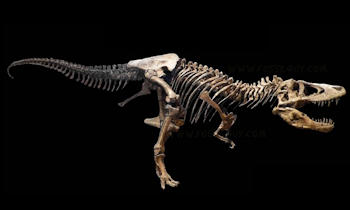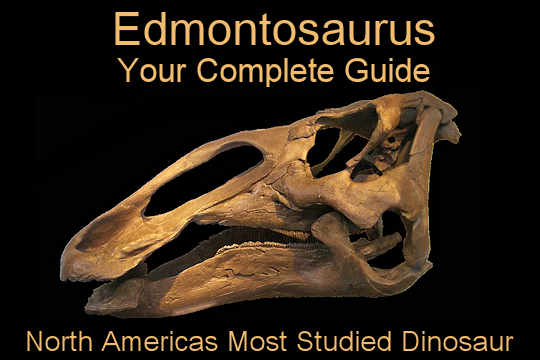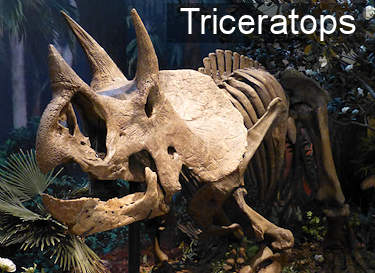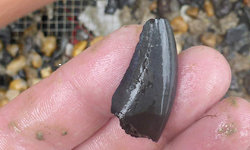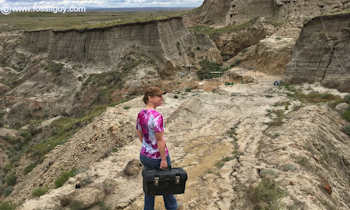Paleontology News

Illustrations of Scelidosaurus holotype showing drawing of parts of the skull and a tooth. From Owen's Monograph of a Fossil Dinosaur of the Lower Lias. (Public Domain)
Scelidosaurus harrisonii, the world's first complete dinosaur skeleton has finally been properly described
After 150 years, the first nearly complete dinosaur ever found has been properly described and classified.
Summary Points

Replica of an 11 foot and nearly complete Scelidosaurus skeleton found in 2000. This replica is on display at the St. George Dinosaur Discovery Site in Utah. Image by: 5of7 (CC BY-SA 2.0)
Scelidosaurus, found in 1858, is the world's first complete dinosaur skeleton recovered.
Scelidosaurus was discovered in Charmouth, Engalnd, the same location Mary Anning would hunt for fossils years before.
The 193-million-year-old dinosaur was not properly described when discovered.
Dr. David Norman recently studied the specimen and others and published separate studies on the animal.
Norman made an accurate reconstruction and found its place among the dinosaur family tree; it's an ancestor to ankylosaurs.
The world's first complete dinosaur skeleton has finally been properly described
This article is based on a Press Release by Sarah Collins at the University of Cambridge - August 27, 2020
The first official complete dinosaur skeleton ever found is credited to James Harrison. In 1858, he found jumbled remains of a dinosaur in the 193 million year old Blue Lias limestone of Charmouth, in west Dorset, England.
One may know Charmouth as the fossil hunting ground of Mary Anning, who only a generation before, hunted fossils here and a few miles west in Lyme Regis. At any rate, Harrison reported the findings to Richard Owen who encouraged him to look for more remains. Soon, an entire skeleton was unearthed... the worlds first complete dinosaur skeleton.
What happened to this specimen? Not much. Owen wrote a few basic papers on its anatomy, but that was it. Over 150 years since that discovery, Dr. David Norman from the University of Cambridge took on a project to prepare and describe this specimen and other Scelidosaur material. Over the year, Norman has published separate studies on the animal, describing its appearance, making accurate reconstructions, and finding its place among the dinosaur family tree.
Some of his findings show the skull was covered in horny scutes with horns on the back of its skull. The entire body was also protected by bony spikes and plates. Norman looked at the phylogenetic position of this dinosaur and concluded it is not a common ancestor to stegosaurs and ankylosaurs as previously thought, but instead is only an ancestor of ankylosaurs.
Norman said "It is unfortunate that such an important dinosaur, discovered at such a critical time in the early study of dinosaurs, was never properly described." "It has now - at last!"
The Journal Articles by Norman about this dinosaur include:
David B Norman. 'Scelidosaurus harrisonii from the Early Jurassic of Dorset, England: cranial anatomy.' Zoological Journal of the Linnean Society (2020). DOI: 10.1093/zoolinnean/zlz074.
David B Norman. 'Scelidosaurus harrisonii from the Early Jurassic of Dorset, England: postcranial skeleton.' Zoological Journal of the Linnean Society (2020). DOI: 10.1093/zoolinnean/zlz078.
David B Norman. 'Scelidosaurus harrisonii from the Early Jurassic of Dorset, England: the dermal skeleton.' Zoological Journal of the Linnean Society (2020). DOI: 10.1093/zoolinnean/zlz085.
David B Norman. 'Scelidosaurus harrisonii (Dinosauria: Ornithischia) from the Early Jurassic of Dorset, England: biology and phylogenetic relationships.' Zoological Journal of the Linnean Society (2020). DOI: 10.1093/zoolinnean/zlaa061.
Recommended Dinosaur Books and Educational Items:
Additional Images:

Vertebrate fauna of the Charmouth Mudstone, Lias Group of England, UK. This shows Scelidosaurus and the more typical marine vertebrates found in the layers. Image by: Nobu Tamura (CC BY-SA 2.0)

A reconstruction of Scelidosaurus harrisonii by Jack Mayer Wood showing a bipedal stance as evidenced by the Holy Cross Mountain trackways. (CC BY-SA 4.0)

Closeup of the skull of Scelidosaurus at the Charmouth Heritage Coast Centre, Charmouth, England. Photo by Ballista (GFDL)
Browse More Paleontology News

High quality Dinosaur teeth by Fossilera







